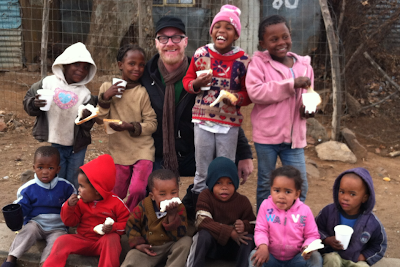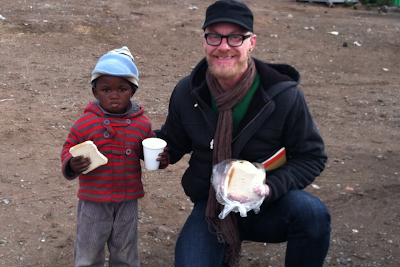.JPG) |
| Teaching HIV prevention to women at Heavenly Valley while Macy, the local HIV educator, observes |
.JPG) |
| Discussing proper use of condoms with my students in the shipping crate turned classroom at Heavenly Valley. |
I've been working or volunteering in the field of HIV/AIDS since 1991. I had shown a passion for the topic when I was a senior in high school and wrote an opinion piece for my English class on Ryan White, the Indiana boy with hemophilia who contracted HIV through a blood transfusion. In a time period when ignorance and fear were rampant, parents at the elementary school rallied to have Ryan White banned from attending school, even though doctors said he posed no risk to other students. The story caught the attention of national media and Ryan White became a poster child for HIV/AIDS education, gaining support from celebrities like Elton John and Elizabeth Taylor. This stigmatizing judgment from people in a town a mere 75 miles away from my home town ignited a passion in me for HIV/AIDS education that endures today.
After graduating from Miami University in 1990, I moved to Binghamton, New York and, within a year, began volunteering for the local branch of People with AIDS Coalition. I'll never forget my first volunteer duty. A family in nearby Endicott, New York had been taking care of the wife's brother, a man in his late 30s sick with full blown AIDS. They called upon the People with AIDS Coalition to send over a few volunteers to stay with him while they attended a graduation ceremony in New Jersey. I eagerly volunteered for one 3-hour shift. I arrived and met the volunteer I would be replacing. She told me that he slept a lot, but seemed to enjoy being read to and eating grapes when he was awake. When he awoke from a nap, I realized what a challenge I had before me. He was emaciated, his eyes were glazed over and the few words he spoke were undiscernible. I was humbled in his presence and followed the directions of the previous volunteer: I read some headlines from an entertainment magazine and fed him bites of cold fruit. I was sad to learn that 2 weeks later he passed away.
This was to be my first of many instances where I took care of friends sick with AIDS. In the next 2 years, three close friends and a number of acquaintances died from illnesses associated with AIDS. Following these losses and a huge snow storm that dumped several feet of snow in Binghamton, my partner Jerial and I moved to Houston. We'd had enough and because of this, I took a break from HIV/AIDS volunteerism.
Four years later, in 1997, I began working as the HIV Services Coordinator for Streetwise Houston, a day shelter for homeless adolescents. I taught HIV prevention and distributed condoms to homeless kids, as well as facilitating support groups for several youth already infected with HIV. This reignited my passion, but it was challenging work in which I saw few results - kids continued to prostitute, use drugs and become infected with HIV. By the fall of 1998, I moved to another nonprofit agency, Montrose Clinic, and began teaching a 5-hour workshop called Next Step for people recently diagnosed with HIV. It was inspiring to take people devastated by a diagnosis through an educational course and have them come out the other side empowered to live a long, healthy life.
Even though its been many years since I facilitated a Next Step workshop, I remember all of the components from infectious body fluids to how the virus weakens the immune system and how the medications stop HIV from replicating. In my initial emails to Come Back Mission, I told them I could teach the course in South Africa, so of course this was worked into my agenda.
They put me in charge of the activities for the day at the Hadassah Centre for Women, so 17 young women and I gathered in the classroom for a day of HIV/AIDS education. I started off with some questions to assess their knowledge level around the subject and found that these were very well educated women in the room. I momentarily questioned how I was going to help expand their knowledge base, but proceeded anyway. I so much enjoyed teaching them the HIV/AIDS curriculum, especially showing them how HIV uses a CD4 immune system cell to reproduce and how the anti-retroviral medications (ARVs) stop the replication cycle. The young women were fascinated and asked so many intelligent questions, some of which challenged me to develop answers.
Because of my success at connecting with the young women at the Hadassah Centre, I was asked to teach some of my HIV/AIDS education to residents of Heavenly Valley, the shanty town of 40 or so shacks where Come Back Mission had a pre-school and women's empowerment center. The following day about 20 people, mostly women, gathered in a shipping container turned classroom to hear my presentation on HIV/AIDS. I knew their knowledge level would be lower and that their first language was Afrikaans, not English, so I adjusted my teaching style. They were slow to respond to my interactive style of teaching - I prefer not to be a lecturer - and know people learn more when they participate in the process, but they soon warmed up.
I became quite amused during the infectious body fluids part of my presentation. As an easy way to teach people how HIV is transmitted while at the same time dispelling myths, I ask participants to name as many body fluids as possible - saliva, tears, sweat, semen, blood, vaginal fluids, etc. Then we discuss which body fluids transmit HIV. The Heavenly Valley residents named 10 of the11 body fluids, but oddly enough they could not name the 11th one: breast milk. Why was it odd? Because during the first 20 minutes of my presentation, two different women were breast feeding their children in the class. (One woman even forgot to cover her breast after her baby had finished feeding, resulting in the first ever "wardrobe malfunction" during one of my presentations.) The women all laughed when I told them the one body fluid they were missing.
After that, the participants were very comfortable with me and began asking all kinds of questions and telling stories, some tragic...some inspiring. It was by far the most challenging presentation I've ever given, and at the same time the most rewarding. We ended the session with a discussion of how stigma against people living with HIV/AIDS harms everyone and leads to myths, misunderstandings, and more HIV infections. Knowing that HIV is so prevalent in their community, I challenged each of them to love and care for their friends of family members living with the disease and be a role model for their community.
The experience led me to the conclusion that I am still very passionate about HIV/AIDS education. While I no longer work in the field, I am determined to continue in some capacity. I am currently the chair of the Community Advisory Board for the Houston Medical Monitoring Project, an HIV/AIDS data collection project currently being conducted nationwide and funded by the CDC. I am also a member of the advisory commitee for LIVE Consortium, a Houston nonprofit dedicated to ending HIV/AIDS stigma. I have also recently agreed to be an advisor for a 6-month leadership training program for African-American gay, bisexual or transgendered young people, where HIV/AIDS is a key component.









.JPG)

















 West Elm
West Elm
